About Us - Raptor
Contacting Us
Introduction
Symbols Glossary
Data Privacy
At a Glance - Raptor
Visual Search
- Steering Wheel - Excluding: Raptor
- Steering Wheel - Raptor
- Steering Wheel - Police
- Instrument Panel - Excluding: Raptor/Police
- Instrument Panel - Raptor
- Instrument Panel - Police Responder
- Vehicle Interior - Excluding: Raptor/Police
- Vehicle Interior - Raptor
- Vehicle Interior
- Front Exterior - Excluding: Raptor/Police
- Front Exterior - Raptor
- Front Exterior - Police
- Rear Exterior - Excluding: Raptor/Police
- Rear Exterior - Raptor
- Rear Exterior - Police
Child Safety
- Child Safety Precautions
- Booster Seats
- Child Safety Locks (If Equipped)
Child Restraint Anchor Points
Child Restraints
Installing Child Restraints
Seatbelts
- Seatbelt Precautions
- Fastening and Unfastening the Seatbelts
- Adjusting the Seatbelts During Pregnancy
- Adjusting the Seatbelt Height
- Adjusting the Seatbelt Length
- Checking the Seatbelts
- Seatbelt Extensions
Sensitive Locking Mode
Automatic Locking Mode
Seatbelt Reminder
Personal Safety System™
Airbags
- How Do the Front Airbags Work
- How Do the Side Airbags Work
- How Do the Knee Airbags Work
- How Does the Safety Canopy™ Work
- Airbag Precautions
- Properly Adjusting the Driver and Front Passenger Seats
- Children and Airbags
- Crash Sensors and Airbag Indicator
- Crash Sensors and Airbag Indicator - Police Responder
- Disposing of Airbags
Front Passenger Sensing System
Pedestrian Alert System (If Equipped)
911 Assist (If Equipped)
Keys and Remote Controls
- Remote Control Limitations
- Using the Remote Control - Police Responder
- Using the Remote Control
- Opening and Closing the Flip Key
- Removing the Key Blade
- Sounding the Panic Alarm
- Locating Your Vehicle
- Changing the Remote Control Battery - Police Responder
- Changing the Remote Control Battery - Vehicles With: Push Button Start
- Changing the Remote Control Battery - Vehicles With: Flip Key
- Replacing a Lost Key or Remote Control
- Programming the Remote Control - Vehicles With: Push Button Start
- Programming the Remote Control - Vehicles With: Flip Key
Keys and Remote Controls – Troubleshooting
MyKey™ (If Equipped)
Doors and Locks
- Doors and Locks Audible Warnings
Operating the Doors From Outside Your Vehicle
Operating the Doors From Inside Your Vehicle
Autounlock (If Equipped)
Autolock (If Equipped)
Mislock (If Equipped)
Doors and Locks – Troubleshooting
Keyless Entry (If Equipped)
- Keyless Entry Limitations
- Keyless Entry Settings
- Using Keyless Entry
Keyless Entry – Troubleshooting
Keyless Entry Keypad (If Equipped)
- What Is the Keyless Entry Keypad
- Keyless Entry Keypad Limitations
- Locating the Keyless Entry Keypad
- Keyless Entry Keypad Master Access Code - Vehicles With: Flip Key
- Keyless Entry Keypad Master Access Code - Vehicles With: Push Button Start
- Keyless Entry Keypad Personal Access Codes
- Using the Keyless Entry Keypad
Keyless Entry Keypad – Troubleshooting
Easy Entry and Exit (If Equipped)
Tailgate - Vehicles With: Manual Tailgate
- Tailgate Precautions
- Locking and Unlocking the Tailgate
- Removing and Installing the Tailgate
- Tailgate Work Surface (If Equipped)
Opening the Tailgate
Tailgate Step (If Equipped)
Bed Extender (If Equipped)
Tailgate - Vehicles With: Power Tailgate
- Tailgate Precautions
- Removing and Installing the Tailgate
- Tailgate Work Surface (If Equipped)
Opening the Tailgate
Closing the Tailgate
Tailgate Step (If Equipped)
Bed Extender (If Equipped)
Tailgate – Troubleshooting
Tailgate - Vehicles With: Remote Release Tailgate
- Tailgate Precautions
- Removing and Installing the Tailgate
- Tailgate Work Surface (If Equipped)
Opening the Tailgate
Tailgate Step (If Equipped)
Bed Extender (If Equipped)
Tailgate – Troubleshooting
Security
Passive Anti-Theft System
Anti-Theft Alarm System (If Equipped)
Anti-Theft Alarm System Settings (If Equipped)
Security – Troubleshooting
Power Running Boards (If Equipped)
Steering Wheel
- Adjusting the Steering Wheel - Vehicles With: Manual Adjustable Steering Column
- Adjusting the Steering Wheel - Vehicles With: Power Adjustable Steering Column
- Resetting the Stopping Position - Vehicles With: Power Adjustable Steering Column
- Horn
- Switching the Heated Steering Wheel On and Off - Vehicles With: Heated Steering Wheel
Adjustable Pedals (If Equipped)
Wipers and Washers
- Checking the Wiper Blades
- Replacing the Front Wiper Blades
- Wipers and Washers Videos
Autowipers (If Equipped)
Washers
Wipers and Washers – Troubleshooting
Exterior Lighting
- Exterior Lighting Control
- Exterior Lighting Control
- Using the Turn Signal Lamps
- How Do Cornering Lamps Work (If Equipped)
- Switching the Daytime Running Lamps On and Off - Vehicles With: Configurable Daytime Running Lamps
- Switching the Daytime Running Lamps On and Off - Vehicles With: Daytime Running Lamps (DRL)
- Using the Front Fog Lamps (If Equipped)
- Switching the Cargo Lamps On
- Switching the Spot Lamps On and Off (If Equipped)
- Using the Off-Road Driving Lamps (If Equipped)
- Exterior Lamps On Audible Warning
- Exterior Lighting Videos
Headlamps – Troubleshooting
Autolamps
Exterior Lamps
Exterior Zone Lighting (If Equipped)
Automatic High Beam Control
Automatic High Beam Control – Troubleshooting
Glare Free Lighting (If Equipped)
Glare Free Lighting – Troubleshooting (If Equipped)
Adaptive Front Lighting (If Equipped)
Interior Lighting
- Switching All of the Interior Lamps On and Off
- Switching the Front Interior Lamps On and Off
- Switching the Front Interior Lamps On and Off - Police Responder
- Switching the Rear Interior Lamps On and Off
- Adjusting the Instrument Panel Lighting Brightness
Interior Lamp Function
Ambient Lighting
Interior Lighting – Troubleshooting
Windows
Interior Mirror
- Interior Mirror Precautions
- Manually Dimming the Interior Mirror
Auto-Dimming Interior Mirror (If Equipped)
Exterior Mirrors
Moonroof (If Equipped)
Instrument Cluster
- Instrument Cluster Overview - Vehicles With: 4.2 Inch Screen
- Instrument Cluster Overview - Vehicles With: 8 Inch Screen
- Instrument Cluster Overview - Vehicles With: 12 Inch Screen
- Tachometer
- Speedometer
- Engine Coolant Temperature Gauge
- Engine Oil Pressure Gauge
- Transmission Fluid Temperature Gauge
- Turbo Boost Gauge (If Equipped)
- What Are the Instrument Cluster Warning Lamps
- Instrument Cluster Warning Lamps
- What Are the Instrument Cluster Indicators
- Instrument Cluster Indicators
Fuel Gauge
Instrument Cluster Display
- Using the Instrument Cluster Display Controls
- Instrument Cluster Display Main Menu - Vehicles With: 12 Inch Screen
- Instrument Cluster Display Main Menu - Raptor
- Instrument Cluster Display Main Menu - Vehicles With: 4.2 Inch Screen
- Instrument Cluster Display Main Menu - Vehicles With: 8 Inch Screen
- Customizing the Instrument Cluster Display
- Brake Coach
- Trip Summary
Trip Computer - Vehicles With: 4.2 Inch Screen
Trip Computer - Vehicles With: 8 Inch Screen/12 Inch Screen
Personalized Settings
Hybrid Display Information
Remote Start (If Equipped)
Climate Control - Vehicles With: Automatic Temperature Control
- Identifying the Climate Control Unit
- Switching Climate Control On and Off
- Switching Recirculated Air On and Off
- Switching Air Conditioning On and Off
- Switching Defrost On and Off
- Switching Maximum Defrost On and Off
- Switching Maximum Cooling On and Off
- Switching the Heated Wiper Park On and Off (If Equipped)
- Switching the Heated Rear Window On and Off
- Setting the Blower Motor Speed
- Switching the Heated Mirrors On and Off
- Setting the Temperature
- Directing the Flow of Air
- Climate Control Hints
Climate Control - Vehicles With: Manual Temperature Control
- Identifying the Climate Control Unit
- Switching Climate Control On and Off
- Switching Recirculated Air On and Off
- Switching Air Conditioning On and Off
- Switching Defrost On and Off
- Switching Maximum Defrost On and Off
- Switching Maximum Cooling On and Off
- Switching the Heated Rear Window On and Off
- Setting the Blower Motor Speed
- Switching the Heated Mirrors On and Off
- Setting the Temperature
- Directing the Flow of Air
- Climate Control Hints
Interior Air Quality
Front Seats
- Front Seat Precautions
- Sitting in the Correct Position
Manual Seats (If Equipped)
Power Seats (If Equipped)
Massage Seats (If Equipped)
Heated Seats (If Equipped)
Ventilated Seats (If Equipped)
Rear Seats (If Equipped)
Rear Occupant Alert System (If Equipped)
Memory Function (If Equipped)
Garage Door Opener (If Equipped)
USB Ports
Power Outlet - Vehicles With: Pickup Bed Power Generator Outlet
- What Is the Power Outlet
- Power Outlet Precautions - Vehicles With: 2kW
- Power Outlet Precautions - Vehicles With: 2.4kW/7.2kW
- Locating the Power Outlets
- Power Outlet Indicators - Vehicles With: 2kW
- Power Outlet Indicators - Vehicles With: 2.4kW/7.2kW
- What Is Utility Idle Mode - Vehicles With: Flip Key
- Switching Utility Idle On and Off - Vehicles With: Flip Key
- What Is Generator Mode
- Switching Generator Mode On and Off
- Resetting Ground Fault Detection
- Resetting the Circuit Breaker - Vehicles With: 7.2kW
- Power Outlet Videos
Power Outlet – Troubleshooting
Power Outlet - Vehicles With: 120V Power Outlet
Power Outlet - Vehicles With: 12V Power Outlet
Center Console Work Surface
- Using the Center Console Work Surface - Vehicles With: Column Shift
- Using the Center Console Work Surface - Vehicles With: Console Shift
Center Console Work Surface – Troubleshooting
Wireless Accessory Charger (If Equipped)
Storage
Cup Holders
Glove Compartment
Under Seat Storage
Glasses Holder
Starting and Stopping the Engine
- Starting and Stopping the Engine – Precautions
- Ignition Switch (If Equipped)
- Push Button Ignition Switch (If Equipped)
- Starting a Gasoline Engine - Vehicles Without: Push Button Start
- Starting a Gasoline Engine - Vehicles With: Push Button Start
- Starting a Hybrid Electric Vehicle System - Vehicles Without: Push Button Start
- Starting a Hybrid Electric Vehicle System - Vehicles With: Push Button Start
- Restarting the Engine After Stopping It - Vehicles With: Push Button Start
- Stopping the Engine When Your Vehicle is Stationary - Vehicles Without: Push Button Start
- Stopping the Engine When Your Vehicle is Stationary - Vehicles With: Push Button Start
- Stopping the Engine When Your Vehicle is Moving - Vehicles Without: Push Button Start
- Stopping the Engine When Your Vehicle is Moving - Vehicles With: Push Button Start
- Accessing the Passive Key Backup Position
- Starting and Stopping the Engine – Warning Lamps
- Starting and Stopping the Engine – Information Messages
- Starting and Stopping the Engine – Frequently Asked Questions - Gasoline, Vehicles Without: Push Button Start
- Starting and Stopping the Engine – Frequently Asked Questions - Gasoline, Vehicles With: Push Button Start
Starting the Engine
Engine Block Heater (If Equipped)
Stopping the Engine
Automatic Engine Stop - Vehicles With: Keyless Entry and Push Button Start
Starting and Stopping the Engine – Troubleshooting
Hybrid Electric Vehicle Information (If Equipped)
- What is a Hybrid Electric Vehicle
- How Does a Hybrid Electric Vehicle Work
- Hybrid Electric Vehicle Driving Characteristics
- Hybrid Electric Vehicle Indicators
Hybrid Electric Vehicle Information – Troubleshooting
Eco Idle – Troubleshooting
Auto-Start-Stop (If Equipped)
Fuel and Refueling
- Fuel and Refueling Precautions
- Locating the Fuel Filler Funnel
- Fuel Tank Capacity - Excluding: Hybrid Electric Vehicle (HEV)
- Fuel Tank Capacity - Hybrid Electric Vehicle (HEV)
Fuel Quality
Running Out of Fuel
Refueling
Fuel and Refueling – Troubleshooting
Catalytic Converter
- What Is the Catalytic Converter
- Catalytic Converter Precautions
Catalytic Converter – Troubleshooting
High Voltage Battery - Hybrid Electric Vehicle (HEV)
Automatic Transmission
- Automatic Transmission Precautions
- Shifting Your Vehicle Into Gear
- Shifting Your Vehicle Into Gear - Raptor
- Shifting Your Vehicle Into Gear - Police Responder
- Automatic Transmission Audible Warnings
- Using Progressive Range Selection
- Stowing the Selector Lever
- Stowing the Selector Lever - Raptor
Automatic Transmission Positions
Manually Shifting Gears
Temporary Neutral Mode
Automatic Return to Park (P)
Manual Park Release
Four-Wheel Drive (If Equipped)
- How Does Four-Wheel Drive Work
- How Does Four-Wheel Drive Work - Raptor
- Four-Wheel Drive Precautions
- Four-Wheel Drive Limitations
- Selecting a Four-Wheel Drive Mode
- Selecting a Four-Wheel Drive Mode - Raptor
- Four-Wheel Drive Indicators
Four-Wheel Drive Modes
Four-Wheel Drive – Troubleshooting
Electronic Locking Differential (If Equipped)
- What Is the Electronic Locking Differential
- How Does the Electronic Locking Differential Work
- How Does the Electronic Locking Differential Work - Raptor
- Electronic Locking Differential Precautions
- Switching the Electronic Locking Differential On and Off - 4x4
- Switching the Electronic Locking Differential On and Off - Raptor
- Switching the Electronic Locking Differential On and Off - 4x2
- Electronic Locking Differential Indicators
Electronic Locking Differential – Troubleshooting
Brakes
- Brake Precautions
- Brake Over Accelerator
- Brake Over Accelerator - Raptor
- Locating the Brake Fluid Reservoir
- Checking the Brake Fluid
- Brake Fluid Specification
Anti-Lock Braking System
Brakes – Troubleshooting
Electric Parking Brake
- What Is the Electric Parking Brake
- Applying the Electric Parking Brake
- Applying the Electric Parking Brake in an Emergency
- Manually Releasing the Electric Parking Brake
- Automatically Releasing the Electric Parking Brake
- Electric Parking Brake Audible Warning
- Releasing the Electric Parking Brake if the Vehicle Battery Has Run Out of Charge
Electric Parking Brake – Troubleshooting
Reverse Brake Assist (If Equipped)
Hill Start Assist
- What Is Hill Start Assist
- How Does Hill Start Assist Work
- Hill Start Assist Precautions
Hill Start Assist – Troubleshooting
Auto Hold
Traction Control
- What Is Traction Control
- How Does Traction Control Work
- Switching Traction Control On and Off
- Traction Control Indicator
Traction Control – Troubleshooting
Stability Control
Trail Control
- What Is Trail Control
- Trail Control Limitations
- Switching Trail Control On and Off
- Setting the Trail Control Speed
- Canceling the Set Speed
- Trail Control Indicators
Trail One Pedal Drive
Trail One Pedal Drive – Troubleshooting
Trail Control – Troubleshooting
Trail Turn Assist (If Equipped)
Hill Descent Control (If Equipped)
Steering
- Steering Videos
Electric Power Steering
Steering – Troubleshooting
Parking Aids (If Equipped)
- Parking Aid Precautions
- Switching Parking Aid On and Off
- Parking Aid Indicators
- Parking Aids Videos
Rear Parking Aid
Front Parking Aid
Side Parking Aid
Parking Aids – Troubleshooting
Rear View Camera
360 Degree Camera (If Equipped)
Active Park Assist (If Equipped)
Cruise Control (If Equipped)
Adaptive Cruise Control (If Equipped)
- How Does Adaptive Cruise Control With Stop and Go Work
- Adaptive Cruise Control Precautions
- Adaptive Cruise Control Limitations
- Switching Adaptive Cruise Control On and Off
- Adaptive Cruise Control Automatic Cancellation
- Setting the Adaptive Cruise Control Speed
- Setting the Adaptive Cruise Control Gap
- Canceling the Set Speed
- Resuming the Set Speed
- Overriding the Set Speed
- Adaptive Cruise Control Indicators
- Switching From Adaptive Cruise Control to Cruise Control
- How Does Intelligent Adaptive Cruise Control Work
- Intelligent Adaptive Cruise Control Precautions
- Intelligent Adaptive Cruise Control Requirements
- Intelligent Adaptive Cruise Control Limitations
- Switching Intelligent Mode On and Off
- Adjusting the Set Speed Tolerance
- Intelligent Adaptive Cruise Control Alerts
- Intelligent Adaptive Cruise Control Indicators
Lane Centering
Intelligent Adaptive Cruise Control
Adaptive Cruise Control – Troubleshooting
BlueCruise (If Equipped)
Drive Mode Control
- What Is Drive Mode Control
- How Does Drive Mode Control Work
- Selecting a Drive Mode
- Selecting a Drive Mode - Raptor
- Baja - Raptor
- Deep Snow/Sand - 4x4
- Eco - 4x4
- Eco - 4x2
- Mud/Ruts - 4x4
- Normal - Raptor
- Normal - 4x4
- Normal - 4x2
- Off-Road
- Rock Crawl - 4x4
- Rock Crawl - Raptor
- Slippery - 4x4, Vehicles With: 2-Speed Torque On Demand
- Slippery - Raptor
- Slippery - 4x4, Vehicles With: Electronic Shift-On-The-Fly
- Slippery - 4x2
- Sport - 4x4, Vehicles With: 2-Speed Torque On Demand
- Sport - Raptor
- Sport - 4x4, Vehicles With: Electronic Shift-On-The-Fly
- Sport - 4x2
- Tow/Haul - 4x4
- Tow/Haul - Raptor
- Tow/Haul - 4x2
- Trail - 4x2
Drive Modes
Drive Mode Control – Troubleshooting
Lane Keeping System (If Equipped)
- What Is the Lane Keeping System
- How Does the Lane Keeping System Work
- Lane Keeping System Precautions
- Lane Keeping System Limitations
- Switching the Lane Keeping System On and Off
- Switching the Lane Keeping System Mode
- Lane Keeping System Indicators
Alert Mode
Aid Mode
Alert and Aid Mode
Lane Keeping System – Troubleshooting
Blind Spot Information System (If Equipped)
- What Is Blind Spot Information System
- How Does Blind Spot Information System Work
- Blind Spot Information System Precautions
- Blind Spot Information System Limitations
- Blind Spot Information System Requirements
- Switching Blind Spot Information System On and Off
- Locating the Blind Spot Information System Sensors
- Blind Spot Information System Indicators
Blind Spot Information System With Trailer Coverage (If Equipped)
Blind Spot Information System – Troubleshooting
Cross Traffic Alert (If Equipped)
Pre-Collision Assist (If Equipped)
- What Is Pre-Collision Assist
- How Does Pre-Collision Assist Work
- Pre-Collision Assist Precautions
- Pre-Collision Assist Limitations
- Switching Pre-Collision Assist On and Off - Police Responder
- Switching Pre-Collision Assist On and Off (If Equipped)
- Locating the Pre-Collision Assist Sensors - Police Responder
- Locating the Pre-Collision Assist Sensors
- Pre-Collision Assist – Warning Lamps
- Pre-Collision Assist – Information Messages - Police Responder
- Pre-Collision Assist – Information Messages
- Pre-Collision Assist – Frequently Asked Questions - Police Responder
- Pre-Collision Assist – Frequently Asked Questions - Vehicles With: Intersection Assist
- Pre-Collision Assist – Frequently Asked Questions
Distance Indication
Automatic Emergency Braking
Evasive Steering Assist
Pre-Collision Assist – Troubleshooting
Driver Alert (If Equipped)
Load Carrying
Pickup Bed
- Pickup Bed Precautions
Pickup Bed Anchor Points
Tailgate Anchor Points
Connecting a Trailer
- Connecting a Trailer Precautions
- Connecting a Trailer
- Trailer Lighting Check
Connecting a Trailer – Troubleshooting
Towing a Trailer
- Towing a Trailer Precautions
- Trailer Brake Precautions
- Towing a Trailer Limitations
- Loading Your Trailer
- Trailer Towing Hints
- Launching or Retrieving a Boat or Personal Watercraft
Towing Weights and Dimensions
Towing a Trailer – Troubleshooting
Integrated Trailer Brake Controller (If Equipped)
- What Is the Integrated Trailer Brake Controller
- Integrated Trailer Brake Controller Precautions
- Using the Integrated Trailer Brake Controller
- Adjusting the Integrated Trailer Brake Controller Mode
Integrated Trailer Brake Controller – Troubleshooting
Trailer Sway Control
Trailer Hitching Assistance (If Equipped)
Smart Hitch (If Equipped)
Onboard Scales (If Equipped)
Trailer Backup Assistance (If Equipped)
- What is Trailer Backup Assistance
- How Does Trailer Backup Assistance Work
- Trailer Backup Assistance Precautions
- Switching Trailer Backup Assistance On and Off
- Using the Trailer Backup Assistance Controller
- Using the Trailer Backup Assistance Views
Setting Up the Trailer Backup Assistance for a Conventional Trailer
Trailer Backup Assistance – Troubleshooting
Trailer Reverse Guidance (If Equipped)
- What Is Trailer Reverse Guidance
- How Does Trailer Reverse Guidance Work
- Trailer Reverse Guidance Precautions
- Switching Trailer Reverse Guidance On and Off
- Using Trailer Reverse Guidance Views
- Trailer Reverse Guidance Videos
Setting Up Trailer Reverse Guidance for a Conventional Trailer
Trailer Reverse Guidance – Troubleshooting
Driving Hints
- What Is Off-Road Driving
- Off-Road Driving Precautions - Raptor
- Basic Off-Road Driving Techniques
- Basic Off-Road Driving Techniques - Raptor
- Driving Off-Road - Raptor
- Driving Your Vehicle at High Speeds - Raptor
- Driving Through Water Limitations - Raptor
- Water Wading
- Off-Road Driving Aids - Raptor
- After Driving Your Vehicle Off-Road
- After Driving Your Vehicle Off-Road - Raptor
- Cold Weather Precautions
- Driving on Snow and Ice
- Breaking-In
- Driving Economically
- Floor Mats
Off-Road Driving
Driving in Special Conditions
Snow Plowing - Vehicles Without: Snow Plow Mode
Snow Plowing - Vehicles With: Snow Plow Mode
Crash and Breakdown Information
- Roadside Assistance
- High Voltage Battery Vehicle Precautions - Hybrid Electric Vehicle (HEV)
- Switching the Hazard Flashers On and Off
- Post-Collision Braking
- Transporting the Vehicle
Jump Starting the Vehicle
Post-Crash Alert System
Automatic Crash Shutoff
Recovery Towing
Towing Your Vehicle
Fuses
- Fuse Precautions
- Identifying Fuse Types
Under Hood Fuse Box
Body Control Module Fuse Box
Fuses – Troubleshooting
Maintenance
- Maintenance Precautions
- Opening and Closing the Hood
- Under Hood Overview - 2.7L EcoBoost™
- Under Hood Overview - 3.3L
- Under Hood Overview - 3.5L Ecoboost™
- Under Hood Overview - 3.5L, Hybrid Electric Vehicle (HEV)
- Under Hood Overview - 5.0L
- Checking the Coolant
- Changing the Fuel Filter - Gasoline
- Changing the 12V Battery
- Adjusting the Headlamps - Vehicles With: LED Headlamps
- Adjusting the Headlamps - Vehicles With: Halogen Headlamps
- Exterior Bulb Specification Chart
- Removing a Rear Lamp Assembly
- Changing a Headlamp Bulb
- Changing a Front Turn Signal Lamp Bulb
- Changing a Front Side Marker Lamp Bulb
- Changing a Front Fog Lamp Bulb (If Equipped)
- Changing a Rear Lamp Bulb
- Changing a Stoplamp Bulb
- Changing a Rear Turn Signal Lamp Bulb
- Changing a Reversing Lamp Bulb
- Changing a High Mounted Stoplamp Bulb
- Changing a License Plate Lamp Bulb
- Drive Belt Routing - 2.7L EcoBoost™, Vehicles With: Dual Generators
- Drive Belt Routing - 2.7L EcoBoost™, Vehicles With: Single Generator
- Drive Belt Routing - 3.3L
- Drive Belt Routing - 3.5L Ecoboost™, Vehicles With: Dual Generators
- Drive Belt Routing - 3.5L Ecoboost™, Vehicles With: Single Generator
- Drive Belt Routing - 3.5L, Hybrid Electric Vehicle (HEV)
- Drive Belt Routing - 5.0L, Vehicles With: Dual Generators
- Drive Belt Routing - 5.0L, Vehicles With: Single Generator
Engine Oil
Engine Air Filter
Exterior Bulbs
Interior Bulbs
Vehicle Care
- Cleaning Products
- Cleaning the Exterior Precautions
- Cleaning the Exterior Precautions - Raptor
- Cleaning Headlamps and Rear Lamps
- Cleaning Windows and Wiper Blades
- Cleaning Chrome, Aluminium or Stainless Steel
- Cleaning Wheels
- Cleaning the Engine Compartment
- Cleaning Stripes or Graphics
- Cleaning Camera Lenses and Sensors
- Cleaning the Underbody
- Repairing Minor Paint Damage
- Waxing Your Vehicle
Cleaning the Exterior
Cleaning the Interior
Storing Your Vehicle
Wheel and Tire Information
Tire Care
Tire Pressure Monitoring System
Changing a Road Wheel
Capacities and Specifications
- Engine Specifications - 2.7L EcoBoost™
- Engine Specifications - 3.3L
- Engine Specifications - 3.5L Ecoboost™
- Engine Specifications - 3.5L, Hybrid Electric Vehicle (HEV)
- Engine Specifications - 5.0L
- Motorcraft Parts - 2.7L EcoBoost™
- Motorcraft Parts - 3.3L
- Motorcraft Parts - 3.5L Ecoboost™
- Motorcraft Parts - Raptor
- Motorcraft Parts - 3.5L, Hybrid Electric Vehicle (HEV)
- Motorcraft Parts - 5.0L
- Engine Oil Capacity and Specification - 2.7L EcoBoost™
- Engine Oil Capacity and Specification - 3.3L
- Engine Oil Capacity and Specification - 3.5L Ecoboost™
- Engine Oil Capacity and Specification - 3.5L, Hybrid Electric Vehicle (HEV)
- Engine Oil Capacity and Specification - 5.0L
- Cooling System Capacity and Specification - 2.7L EcoBoost™
- Cooling System Capacity and Specification - 3.3L
- Cooling System Capacity and Specification - 3.5L Ecoboost™
- Cooling System Capacity and Specification - Raptor
- Cooling System Capacity and Specification - 3.5L, Hybrid Electric Vehicle (HEV)
- Cooling System Capacity and Specification - 5.0L
- Fuel Tank Capacity - Gasoline, Excluding: Hybrid Electric Vehicle (HEV)
- Fuel Tank Capacity - Raptor
- Fuel Tank Capacity - Gasoline, Hybrid Electric Vehicle (HEV)
- Air Conditioning System Capacity and Specification - 2.7L EcoBoost™
- Air Conditioning System Capacity and Specification - 3.3L
- Air Conditioning System Capacity and Specification - 3.5L Ecoboost™
- Air Conditioning System Capacity and Specification - 3.5L, Hybrid Electric Vehicle (HEV)
- Air Conditioning System Capacity and Specification - 5.0L
- Washer Fluid Specification
- Brake Fluid Specification
- Transfer Case Fluid Capacity and Specification
- Transfer Case Fluid Capacity and Specification - Raptor
- Front Axle Fluid Capacity and Specification
- Rear Axle Fluid Capacity and Specification
- Rear Axle Fluid Capacity and Specification - Raptor
- Rear Axle Fluid Capacity and Specification - Police Responder
Vehicle Identification
Vehicle Identification Number
Connected Vehicle
- What Is a Connected Vehicle
- Connected Vehicle Requirements
- Connected Vehicle Limitations
- Connecting the Vehicle to a Wi-Fi Network
- Connected Vehicle Settings
Connecting the Vehicle to a Mobile Network
Connected Vehicle – Troubleshooting
Vehicle Wi-Fi Hotspot
Audio System
- Audio System Precautions
- Identifying the Audio Unit
- Switching the Audio Unit On and Off
- Selecting the Audio Source
- Playing or Pausing the Audio Source
- Adjusting the Volume
- Switching Shuffle Mode On and Off
- Switching Repeat Mode On and Off
- Setting a Memory Preset
- Muting the Audio
- Adjusting the Sound Settings
- Setting the Clock and Date
- Switching the Display On and Off
AM/FM Radio
Digital Radio (If Equipped)
Satellite Radio (If Equipped)
Audio System – Troubleshooting
Center Display
Voice Interaction
Alexa Built-In
Phone
Apps
Personal Profiles (If Equipped)
Navigation (If Equipped)
- Connected Navigation
- Accessing Navigation
- Navigation Map Updates
- Trailer Towing Navigation
Adjusting the Map
Live Traffic
Setting a Destination
Waypoints
Route Guidance
Driver Identification (If Equipped)
- How Does Driver Identification Work
- Signing In as a Driver
Driver Identification – Troubleshooting
Vehicle Software Updates
Vehicle System Reset
Accessories
Auxiliary Switches
Warranty Terms and Conditions - Raptor
Ford Protect
Scheduled Maintenance
Customer Information
- Rollover Warning
- The Better Business Bureau Auto Line Program
- The Mediation and Arbitration Program
- Ordering a Canadian French Owner's Manual
- Reporting Safety Defects in the United States
- Reporting Safety Defects in Canada
- Blind Spot Information System Sensors
- Body Control Module
- Cruise Control Module
- Keys and Remote Controls
- Passive Anti-Theft System
- Radio Transceiver Module
- SYNC
- Telematics Control Unit
- Tire Pressure Monitoring System Sensors - Vehicles With: 315 MHz Sensors
- Tire Pressure Monitoring System Sensors - Vehicles With: 433 MHz Sensors
- Wireless Accessory Charging Module
- Perchlorate
- Replacement Parts Recommendation
- Mobile Communications Equipment
- End User License Agreement
- Emission Law
- Export Unique Options
- Warranty Information
Radio Frequency Certification Labels
Decommissioning the Vehicle
Appendices
This view of the Owner's Manual contains the very latest information, which may vary slightly from the printed Owner's Manual originally provided with your vehicle. It may also describe content that is not on or operates differently on your vehicle. Please consider the Owner's Manual originally provided with your vehicle as the primary source of information for your vehicle.
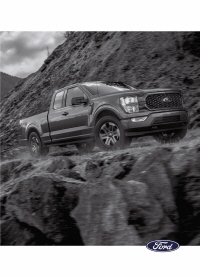
The information contained in this publication was correct at the time of release.In the interest of continuous development, we reserve the right to change specifications, design or equipment at any time without notice or obligation.No part of this publication may be reproduced, transmitted, stored in a retrieval system or translated into any language in any form by any means without our written permission.Errors and omissions excepted.
Copyright © 2024 Ford Motor Company
Changing a Flat Tire - Raptor/Tremor
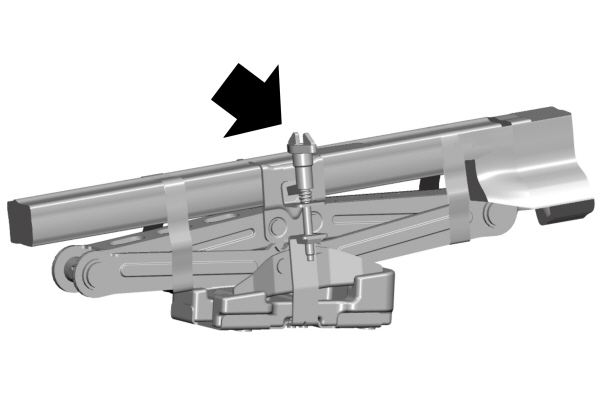
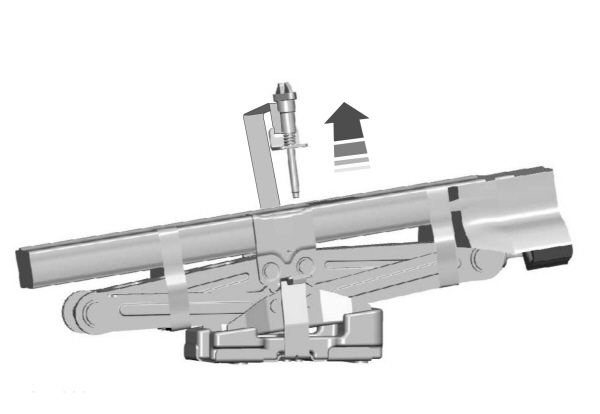

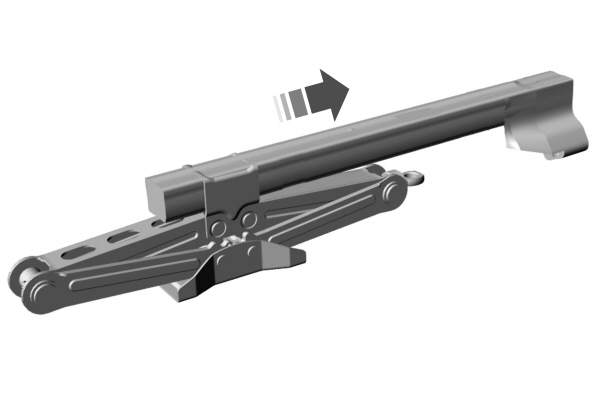
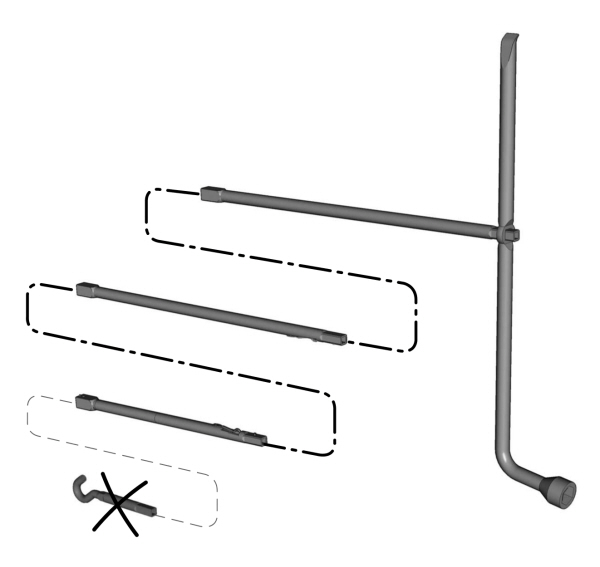
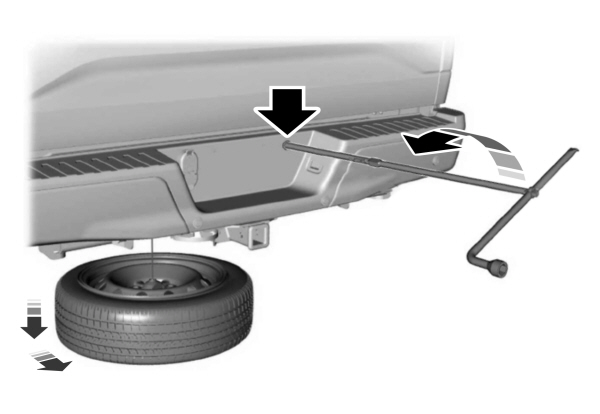
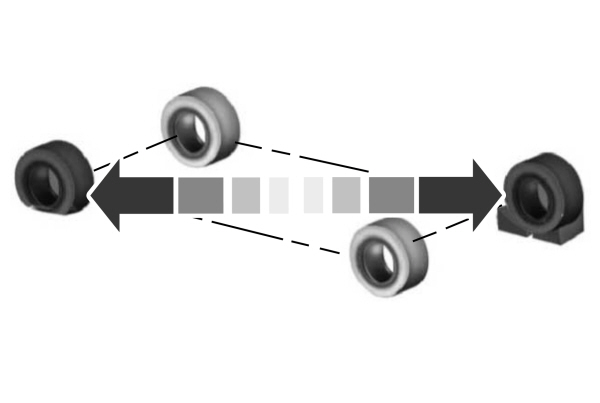

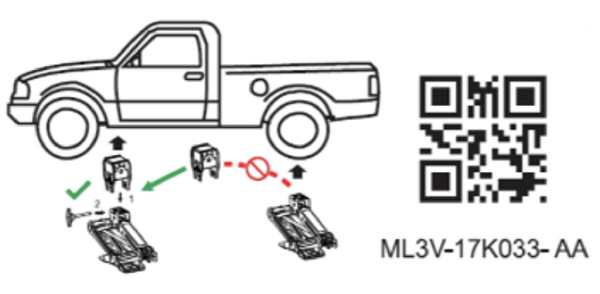
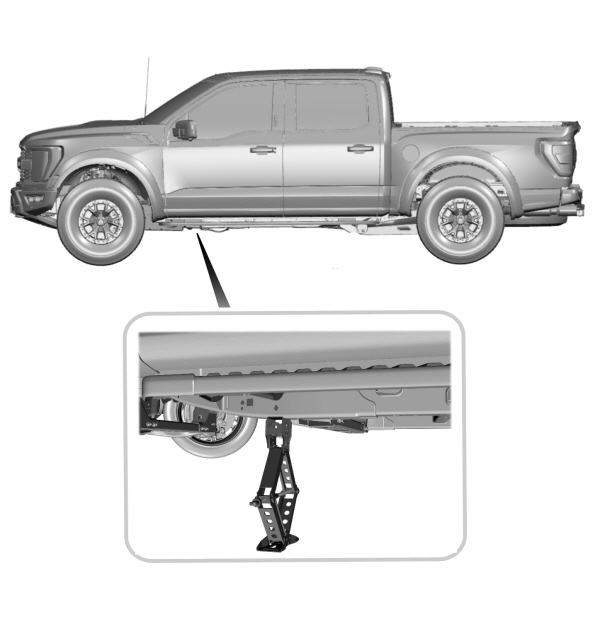


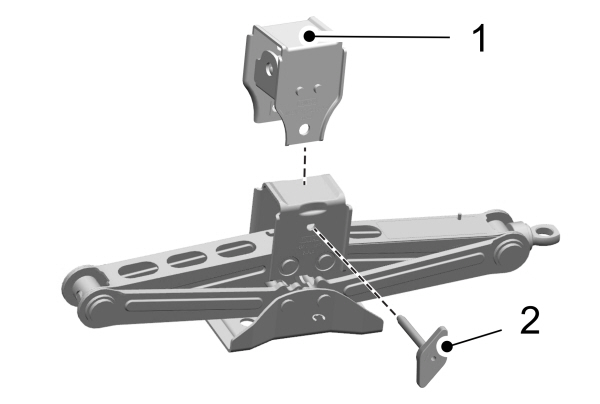

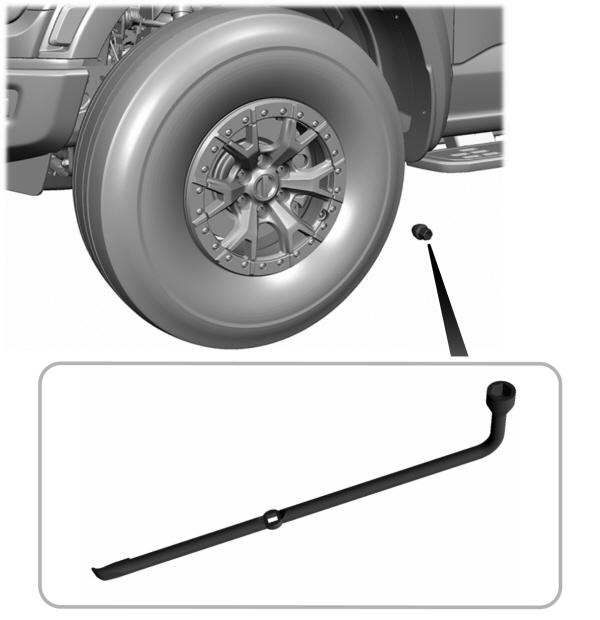
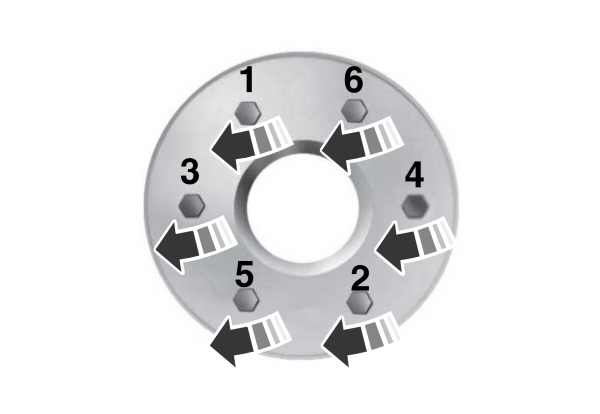
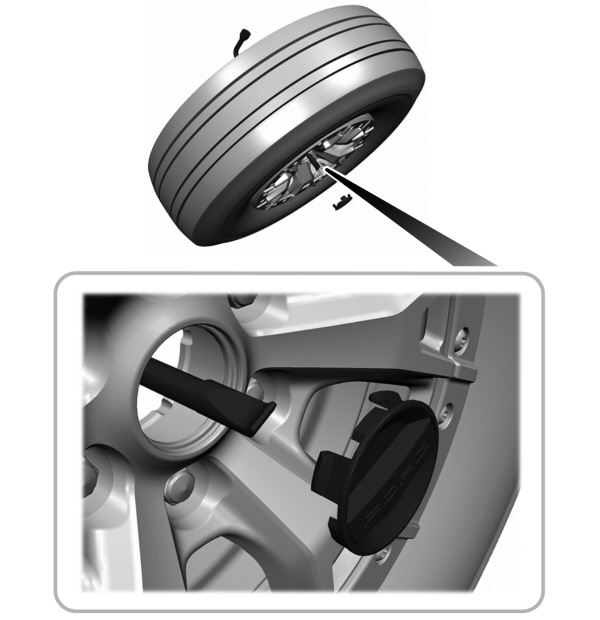

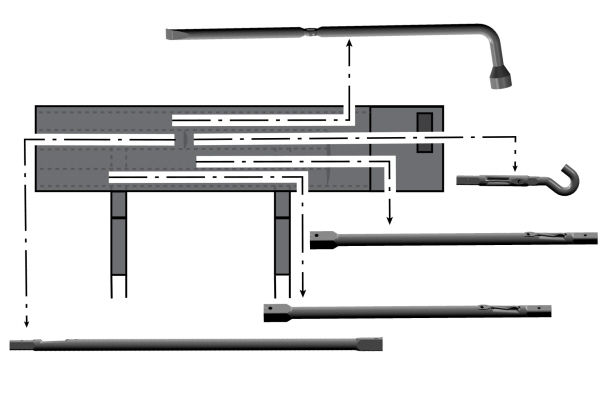
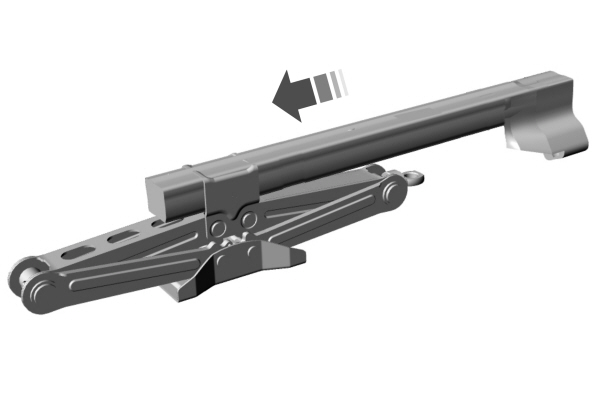

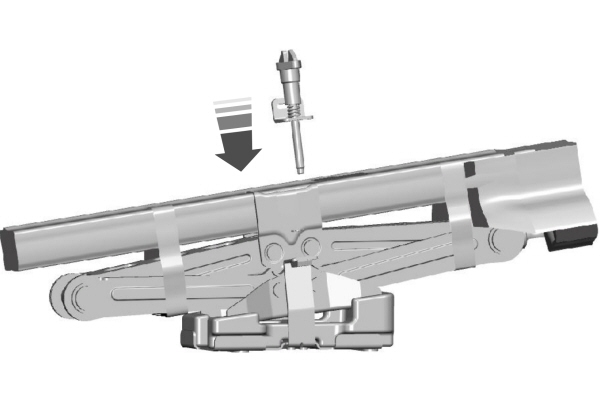

If you get a flat tire when driving, do not apply the brake heavily. Instead, gradually decrease your speed, hold the steering wheel firmly and slowly move to a safe place on the side of the road.
Have a flat serviced by an authorized dealer to prevent damage to the system sensors. See
Tire Pressure Monitoring System Precautions.
Replace the spare tire with a road tire as soon as possible. When repairing or replacing the flat tire, have the authorized dealer inspect the system sensor for damage.
Note:
Only use tire sealants in roadside emergencies as they may damage the tire pressure monitoring system sensor.
Note:
The tire pressure monitoring system indicator light illuminates when the spare tire is in use. To restore the full functionality of the monitoring system, all road wheels that come with tire pressure monitoring sensors must be mounted on the vehicle.
Dissimilar Spare Wheel and Tire Assembly Information
 WARNING:
Failure to follow these guidelines could result in an increased risk of loss of vehicle control, injury or death.
WARNING:
Failure to follow these guidelines could result in an increased risk of loss of vehicle control, injury or death. |
If you have a dissimilar spare wheel and tire, the intent of the spare wheel is for temporary use only. This means that if you need to use it, replace it as soon as possible with a road wheel and tire assembly that is the same size and type as the road tires and wheels originally provided by Ford.
A dissimilar spare wheel and tire assembly is defined as a spare wheel and tire assembly that is different in brand, size or appearance from the road tires and wheels.
Full-size dissimilar spare
When driving with the full-size dissimilar spare wheel and tire assembly, do not: - Exceed 70 mph (113 km/h).
- Use more than one dissimilar spare wheel and tire assembly at a time.
- Use snow chains on the end of the vehicle with the dissimilar spare wheel and tire assembly.
- Engage any four-wheel drive mode. See Four-Wheel Drive Limitations.
- Engage any four-wheel drive.
- Handling, stability and braking performance.
- Comfort and noise.
- Ground clearance and parking at curbs.
- Winter weather driving capability.
- Wet weather driving capability.
- Four-wheel drive capability.
- Towing a trailer.
- Driving vehicles that come with a camper body.
- Driving vehicles with a load on the cargo rack.
Drive cautiously when using a full-size dissimilar spare wheel and tire assembly and seek service as soon as possible.
Tire Change Procedure
 WARNING:
To help prevent your vehicle from moving when changing a wheel, shift the transmission into park (P), set the parking brake and use an appropriate block or wheel chock to secure the wheel diagonally opposite to the wheel being changed. For example, when changing the front left wheel, place an appropriate block or wheel chock on the right rear wheel.
WARNING:
To help prevent your vehicle from moving when changing a wheel, shift the transmission into park (P), set the parking brake and use an appropriate block or wheel chock to secure the wheel diagonally opposite to the wheel being changed. For example, when changing the front left wheel, place an appropriate block or wheel chock on the right rear wheel. WARNING:
The jack supplied with this vehicle is only intended for changing a flat tire in an emergency. Do not attempt to do any other work on your vehicle when it is supported by the jack, as your vehicle could slip off the jack. Failure to follow this instruction could result in personal injury or death.
WARNING:
The jack supplied with this vehicle is only intended for changing a flat tire in an emergency. Do not attempt to do any other work on your vehicle when it is supported by the jack, as your vehicle could slip off the jack. Failure to follow this instruction could result in personal injury or death. WARNING:
Do not attempt to change a tire on the side of the vehicle close to moving traffic. Pull far enough off the road to not obstruct the flow of traffic and avoid the danger of being hit when operating the jack or changing the wheel.
WARNING:
Do not attempt to change a tire on the side of the vehicle close to moving traffic. Pull far enough off the road to not obstruct the flow of traffic and avoid the danger of being hit when operating the jack or changing the wheel. WARNING:
Only use the jack provided as original equipment with your vehicle.
WARNING:
Only use the jack provided as original equipment with your vehicle. WARNING:
Do not get under a vehicle that is supported by a jack.
WARNING:
Do not get under a vehicle that is supported by a jack. WARNING:
The jack should be used on level firm ground wherever possible.
WARNING:
The jack should be used on level firm ground wherever possible. WARNING:
Never place anything between the vehicle jack and the ground.
WARNING:
Never place anything between the vehicle jack and the ground. WARNING:
Never place anything between the vehicle jack and your vehicle.
WARNING:
Never place anything between the vehicle jack and your vehicle. WARNING:
It is recommended that the wheels of the vehicle be chocked, and that no person should remain in a vehicle that is being jacked.
WARNING:
It is recommended that the wheels of the vehicle be chocked, and that no person should remain in a vehicle that is being jacked. WARNING:
Switch off the running boards before jacking or placing any object under your vehicle. Never place your hand between the extended running board and your vehicle. A moving running board may cause injury.
WARNING:
Switch off the running boards before jacking or placing any object under your vehicle. Never place your hand between the extended running board and your vehicle. A moving running board may cause injury. WARNING:
Only use the specified jacking points. If you use any other locations you could damage vehicle components, such as brake lines.
WARNING:
Only use the specified jacking points. If you use any other locations you could damage vehicle components, such as brake lines. |
Park on a level surface, activate the hazard flashers and set the parking brake. Place the transmission in park (P) and turn the engine off.
Note:
Only use the spare tire carrier to stow the tire and wheel combination provided with your vehicle. Other tire and wheel combinations can cause the tire carrier to fail.
Note:
Do not use impact tools or power tools operating at over 200 RPM on the spare tire carrier, this could cause a winch malfunction and prevent a secure fit.
Note:
Passengers should not remain in the vehicle when the vehicle is being jacked.
Removing the Vehicle Jack and Tool Bag
The vehicle jack and tool bag are in the rear passenger side of your vehicle, behind the passenger seat.

- Turn the wing bolt on the jack bracket counterclockwise to release the jack and tool bag from the jack bracket.

- Remove the jack and tool bag from the jack bracket.

- Release the jack tool bag straps.

- Access the jack tools by sliding the jack tool bag through the jack load rest.
- Remove the tools from the tool bag.
Note:
Your jack does not require maintenance or additional lubrication over the service life of your vehicle.
Removing the Spare Tire
The spare tire is under the vehicle, just forward of the rear bumper.
Note:
Remove the hook end from the assembled jack handle before continuing.
- Use your key to remove the lock cylinder from the access hole of the bumper to allow access to the guide tube.

- Assemble the jack handle as shown in the illustration.

- Fully insert the jack handle through the bumper hole and into the guide tube through the access hole in the rear bumper. Turn the handle counterclockwise until you lower the tire to the ground and the cable is slightly slack so you can slide the tire rearward from under the vehicle.
- Remove the retainer from the center of the wheel.

- Block both the front and rear of the wheel diagonally opposite the flat tire. For example, if the left front tire is flat, block the right rear wheel.
- Obtain the spare tire and vehicle jack from their storage locations.
- Loosen each wheel nut on the affected flat tire one-half turn counterclockwise but do not remove.
Jacking the Vehicle


Front Jacking Points

Note:
Use the frame rail as the front jacking location point, not the control arm. There is an arrow marked on the frame rail.
Rear Jacking Points

Note:
Jack at the specified locations to avoid damage to the vehicle.


| 1. 2. |
- Place the vehicle jack at the jacking point next to the tire you are changing.
- When jacking the vehicle to service a front wheel/tire, remove the wing bolt holding the extension block to the jack stowage bracket and reuse wing bolt to attach extension block to jacking surface.
Note:
Do not use the extension block when jacking the rear tire position.
Note:
If servicing a rear tire position, the extension block is not needed.
- Reassemble the jack handle, including the S-hook, to the lug wrench. Insert the S-hook into the eyelet of the jack and turn the jack handle clockwise until the wheel is completely off the ground.

- Remove the wheel nuts with the lug wrench.

- Replace the flat tire with the spare tire, making sure the valve stem is facing outward. Reinstall the wheel nuts until the wheel is snug against the hub. Do not fully tighten the wheel nuts until you lower the wheel.
- Lower the wheel by turning the jack handle counterclockwise.
- Remove the vehicle jack and fully tighten the wheel nuts in the order shown.

- Remove the wheel trim with the wheel nut trim remover provided on the end of the wheel nut wrench.

Note:
Stow the center wheel trim in a safe location for replacement on the wheel when repaired.
- Stow the flat tire.
- Stow the vehicle jack and lug wrench. Make sure the jack is securely fastened before you drive.
- Unblock the wheels.
Stowing the Flat or Spare Tire
Note:
Failure to follow the spare tire stowage instructions could result in failure of the cable or loss of the spare tire.
- Lay the tire on the ground with the valve stem facing up.
- Slide the wheel partially under the vehicle and install the retainer through the wheel center. Pull on the cable to align the components at the end of the cable.
- Turn the jack handle clockwise until you raise the tire to its stowed position underneath the vehicle. The effort to turn the jack handle increases significantly and the spare tire carrier ratchets or slips when you raise the tire to the maximum tightness. Tighten to the point where the ratchet or slip occurs a minimum of three times, as indicated by an audible click each time. The spare tire carrier does not allow you to overtighten. If the spare tire carrier ratchets or slips with little effort, have your vehicle checked as soon as possible.
- Check that the tire lies flat against the frame and you properly tighten it. Try to push or pull, then turn the tire to be sure it does not move. Loosen and retighten, if necessary. Failure to properly stow the spare tire could result in failure of the winch cable and loss of the tire.
- Repeat this tightness check procedure when servicing the spare tire pressure, every six months, as per your scheduled maintenance information, or at any time that the spare tire gets disturbed through service of other components.
- If removed, install the spare tire lock into the bumper drive tube with the spare tire lock key and jack handle.
Stowing the Vehicle Jack and Tool Bag

- Turn the lead screw eyelet to adjust the jack up or down until the stowage markings on the upper channel align with the lower channel.

- Place the tools inside of the tool bag.

- Install the tool bag through the vehicle jack load rest.
- Restow the extension block and wing bolt to the jack bracket.

- Secure the jack tool bag straps around the vehicle jack.

- Place the jack and tool bag back onto the jack bracket.

- Turn the wing bolt on the jack bracket clockwise until you secure the jack and tools to the jack bracket.
Thank You For Your Feedback
